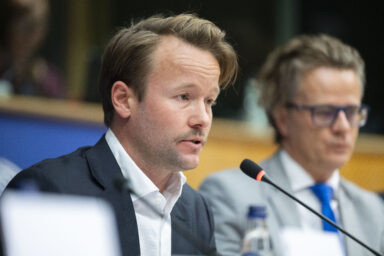The European Union has formally launched its union-wide prevention, preparedness and response plan for health crises. The plan introduces a new framework, strengthening Europe’s ability to anticipate, manage and recover from serious cross-border health threats.
The changes should overall bolster the EU’s health preparedness architecture. It provides policymakers, crisis managers and stakeholders with practical tools, enabling faster and more coordinated action during public or national health emergencies. It applies to all potential health hazards and crises. This includes natural, accidental and intentional events. It is no surprise that a wide range of threats can trigger such situations.
According to the European Commission, the plan outlines the full governance framework for managing health crises across all phases of the crisis cycle. It clarifies how EU-level capacities operate. This includes surveillance systems, coordination mechanisms and support structures. The goals is to protect the health and well-being of people across the union and ensure the continuity of essential services at a moment when disruption can chaos to spill over.
“The COVID-19 pandemic has highlighted the importance of anticipating threats and being ready to react quickly and effectively when crises strike”, said Commissioner for Health and Animal Welfare Olivér Várhelyi. “By linking national and EU efforts better, today’s plan gives us a solid set of tools to prepare for, prevent and respond to health crisis more robustly. This will help to manage impacts, protect people and support recovery,” he added.
You might be interested
The COVID-19 pandemic has highlighted the importance of anticipating threats and being ready to react quickly and effectively when crises strike. – Olivér Várhelyi, European Commissioner for Health and Animal Welfare
Toolbox rooted in the Preparedness Union Strategy
The Union plan represents a key action under the EU Preparedness Union Strategy. Regulation (EU) 2022/2371 on serious cross-border threats to health legally anchors it. This regulation forms the cornerstone of the EU Health Security Framework.
The Strategy responds to what the Niinistö Report identified as an urgent need for stronger EU-level coordination in preparedness and readiness. It stresses that health security is a shared European responsibility rather than solely a national one.
The plan delivers what the Preparedness Union Strategy’s Action Plan committed to: a coherent framework by the end of 2025. This framework aligns the many actors and instruments within the EU’s reinforced health security architecture. It follows a proactive crisis management model based on three mutually reinforcing principles. All-hazards, whole-of-government and whole-of-society, grounded in the One Health approach, which recognises the interdependence of human, animal and environmental health.
As stated in the plan: “The lessons from recent years are clear. Preparedness for cross-border health crises is not a matter of choice, it is a necessity.”
It also identifies key building blocks. These include the Regulation on serious cross-border threats to health, the strengthened mandates of the European Centre for Disease Prevention and Control and the European Medicines Agency, and the creation of the Commission’s Health Emergency Preparedness and Response Authority (HERA). These measures aim to improve preparedness and response in the area of medical countermeasures.
The lessons from recent years are clear.
From preparedness to response and recovery
The plan contains four phases of health crisis management: prevention and preparedness, detection and assessment, response and recovery. It details how member states and EU institutions coordinate across each phase. The objective is to ensure resilient health systems and rapid action when needed.
In the prevention and preparedness phase, member states must develop and regularly update their national plans. They must also coordinate with the Commission through the Health Security Committee. The ECDC conducts preparedness assessments and provides recommendations to improve national readiness. The Commission, supported by Member States through the HERA Board, facilitates the development, availability and distribution of medical countermeasures. These include vaccines, diagnostics, therapeutics, medical devices and protective equipment.
To ensure manufacturing readiness, vaccine production capacity has been reserved through EU FAB. This provides immediate surge capability in the event of a crisis.
The detection and assessment phase strengthens integrated surveillance mechanisms across the Union. It combines laboratory-based monitoring, wastewater analysis, vector surveillance and One Health approaches. Information sharing and interoperable data systems support early warning and threat assessment. EU agencies such as ECDC, EMA and EFSA contribute rapid public health risk assessments. These guide evidence-based decision-making.
Response and recovery
In the response phase, coordination takes place through the Health Security Committee. It is chaired by the Commission. Member States align crisis management and public health measures. The Commission, supported by HERA, coordinates the availability and accessibility of medical countermeasures. If necessary, it may formally recognise a public health emergency at Union level. This unlocks additional resources and extended agency mandates.
The Health Crisis Board then coordinates supply and access to crisis-relevant medical countermeasures, working alongside broader EU crisis mechanisms such as the Union Civil Protection Mechanism, ReliefEU and the Council’s Integrated Political Crisis Response arrangements. Temporary travel restrictions, border controls and export control mechanisms may be introduced where necessary to safeguard access to critical supplies.
Recovery focuses on learning and resilience. The plan calls for systematic in-action and after-action reviews. Lessons learned must be translated into updated policies and legal frameworks. Independent evaluations will be conducted by bodies such as the Scientific Advice Mechanism and the European Court of Auditors. Transparent communication is essential. So is attention to the social and economic impact on disproportionately affected groups.
A living document designed for adaptation
The Commission emphasises that the union plan is a living document. It will evolve as new challenges emerge. It will also adapt as lessons are learned from real-life emergencies. The plan will be regularly tested through simulation exercises. The first is scheduled for 2026, ensuring its relevance and effectiveness in responding to future threats.
The document is primarily intended for national authorities responsible for crisis management and policy implementation. It also benefits EU agencies, international partners such as the World Health Organization. Civil society, academia, the private sector and the media will also use it.
Future actions and strategic alignment
The plan aligns with a broader set of strategic initiatives. These include the Medical Countermeasures Strategy and the Stockpiling Strategy adopted in 2025. It also connects to future actions. These include an EU Crisis Coordination Hub in 2027 and minimum preparedness requirements in 2026. Comprehensive civil-military preparedness arrangements are also foreseen. It is further reinforced by the Global Health Resilience Initiative announced by Commission President Ursula von der Leyen in her State of the Union address. It also aligns with the BE READY European partnership on pandemic preparedness, expected in January 2026.
“Together, we are building a stronger, more resilient, and inclusive European Health Union, ensuring that everyone is protected in the face of cross-border threats to health,” the Commission stated.
The implementation and continuous updating of the Union plan will rely on coordinated action between the Commission, Member States, EU institutions and agencies. The Health Security Committee will serve as the central platform for oversight and knowledge exchange.











